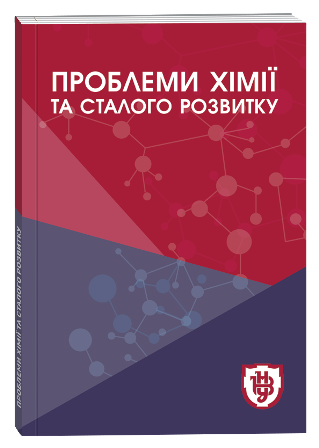ASSESSMENT OF ANTIFUNGAL ACTIVITY OF SOME PYRROLIDINONES AND CONDENSED AZEPINONES
DOI:
https://doi.org/10.32782/pcsd-2022-3-5Keywords:
pyrrolidinones, azepinones, antifungal activity, bioscreening, cyclization, amides of styrylacetic acids, polyphosphoric acid, arylsulfenyl chloridesAbstract
The work is devoted to the study of the antifungal activity of some derivatives of pyrrolidinones and condensed azepinones obtained as a result of electrophilic intramolecular cyclization of N-unsubstituted, N-alkyl-, N-aryl- and N-heterylamides of styrylacetic acids with different substituents in the styrene part of the molecule under the action of polyphosphoric acid and arylsulfenyl chlorides, as effective electrophilic reagents for the mentioned substrates. The introductory part of the article reveals the importance of amides of unsaturated carboxylic acids for the construction of biologically active heterocyclic substrates, which are promising for the search for bioregulators of a wide spectrum of action. The general scheme for obtaining 1-unsubstituted and 1-substituted 5-aryl(heteryl)pyrrolidin-2-ones, 2H-benzazepin- 2-ones, 2H-naphtho[1,2-b]-, 2H-naphtho[2,1 -b]- and 2H-naphtho[2,3-b]azepin-2-ones and 5H-thieno[3,2-b]azepin-5- ones and their sulfonyl derivatives. Antifungal activity was evaluated by the value of the minimum fungistatic concentration (MfsK) in relation to a number of yeast-like fungi (Asp. fumigatus K 11, Asp. niger K 9, Asp. amstelodami K12, Tr. mentagrophytes var. interdigitale and Tr. interdigitale ATCC 9533). The obtained results show that the minimum fungistatic concentration for the studied compounds varies widely (MfsK = 3.90-125 μg / ml). Among the spectrum of used strains of microorganisms, the latter were more selective for the fungus Asp. fumigatus K 11, in particular for compounds 1d,e and 2d, the minimum fungistatic concentration is 3.90 μg/ml, which is at the level of the antifungal drug "Mycospor", which was used as a control. The obtained results prove the perspective and feasibility of using electrophilic intramolecular cyclization of amides of styroacetic acids to obtain new effective antifungal drugs.
References
Andrianov V., Gulite V., Lola D., Loza E., Semenikhina V., Kalvinsh I., Petersen K.D., Ritchie J.W.A., Khan N., Tumber A., Collins L.S., Vadlomudi S.M., Bjokling F., Sehested N. Novel amide derivatives as inhibitors of histone deacetylase: design, synthesis and SAR. Eur. J. Med. Chem. 2009. 44. Р. 1067-1085.
Legoabe L., Kruger J., Petzer A., Petzer J.P. Monoamine oxidase inhibition by selected anilide derivatives. Eur. J. Med. Chem. 2011. 46. Р. 5162-5174.
Ozaki F., Matsukura M., Kabasawa Y., Ishibashi K., Ikemori M., Hamano S., Minami N. Synthesis and cardiovascular activity of phenylalkylamine derivatives. I. Potential specific bradycardic agents. Chem. Pharm. Bull. 1992. 40. Р. 2735-2740.
Dothager R.S., Putt K.S., Allen B.J., Leslie B.I., Nesterenko V., Hergenrother P.J. Synthesis and Identification of Small Molecules that Potently Induce Apoptosis in Melanoma Cells through G1 Cell Cycle Arrest. J. Am. Chem. Soc. 2005. 127. Р. 8686-8696.
Данилюк І.Ю. Електрофільна внутрішньомолекулярна циклізація амідів стирилоцтових кислот : дис. … кандидата хімічних наук : 02.00.03 / Данилюк Іванна Юріївна. – Київ: 2019. – 180 с.
Danyliuk I.Y., Vaskevych R.I., Vaskevych A.I., Rusanov E.B., Vovk M.V. Sulfanyl chloride induced heterocyclization of N-(pyrazolyl)styrylacetamides. Phosphorus Sulfur Silicon Relat. Elem. 2019. 194. P. 156-162.
Danyliuk I.Y., Vaskevych R.I., Vaskevych A.I., Suikov S.Y., Rusanov E.B., Chornous V.O., Vovk M.V. Synthesis of naphtho[1,2-b]-, naphtho[2,1-b]-, and naphtho[2,3-b]azepinones via proton-induced cyclization of N-1(2)-naphthyl styrylacetamides. J. Heterocycl. Chem. 2020. 57. P. 317-326.
Danyliuk I.Y., Vaskevych A.I., Vaskevych R.I., Rusanov E.B., Vovk M.V. Cyclosulfenylation of N-(1(2)-naphthyl) styrylacetamides as a synthetic route to 4(2)-arylthio naphtho[1,2-b]([2,1-b])azepin-2(4)-ones. J. Sulphur. Chem. 2021. 42. P. 264-280.
Crowley P.D., Gallagher H.C. Clotrimazole as a pharmaceutical: past, present and future. J. Appl. Microbiol. 2014. No 117 (3). P. 611–617.
Yakovychuk N.D. et al. Аntifungal activity of 5-(2-nitrovinyl)imidazoles and their derivatives against the causative agents of vulvovaginal candidiasis. Regulatory Mechanisms in Biosystems. 2018. No 9 (3). P. 369–373.
Некрасова, Л.С.; Свита, В.М.; Глушкевич, Т.Г. Визначення чутливості мікроорганізмів до антибактеріальних препаратів. Методичні вказівки МВ 9.9.5-143-2007. Київ: МОЗ України, Державна сан.-епід. служба, 2007. 79 с.






